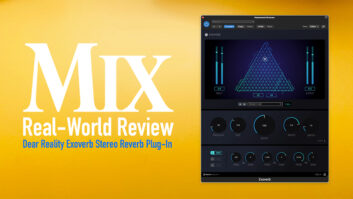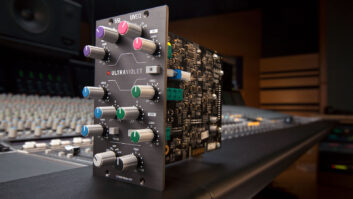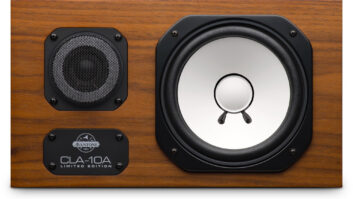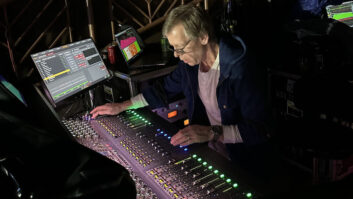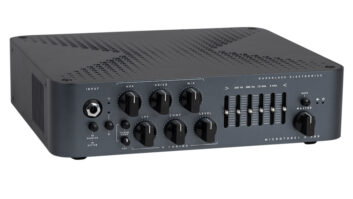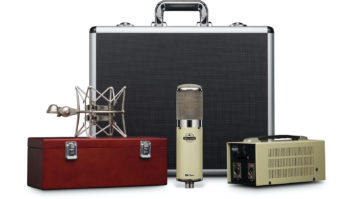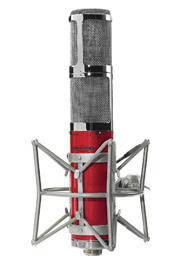
Topping Avant Electronics’ line of C Series condenser mics, the Avantone CK-40 uses two 35mm, center-terminated gold-sputtered capsules mounted in separate cavities — one above the other. While the lower-capsule assembly is fixed, the upper rotates from 90 to 270 degrees. Priced at $599, the CK-40 ships with a basket shock-mount, 32-foot cable, splitter/fan-out box, foam pop filter and padded aluminum attaché case.
A CLOSER LOOK INSIDE
The CK-40’s chassis and electronics are housed in a machined-brass tube and held in place by a large chromed nut at the bottom. The housing is finished in a metallic Cabernet wine-red that contrasts with chrome plating on the mesh screening and other metal parts. Inside, two matched circuit boards contain the discrete Class-A design FET (Field Effect Transistor) head amps and line drivers. There are no transformers in this mic. The mic is rated at just 17dBA (A-weighted) noise level, with a max SPL of 147 dB and a 20 to 20k Hz (±3dB) frequency response. A single, 5-pin stereo XLR connector at the bottom of the mic sends audio for both mics down a cable to a small splitter box terminating in standard male 3-pin XLRs. The mic is phantom-powered and draws 3 mA of current for each capsule.
The CK-40 has two sets of rugged, onboard, three-way toggle switches: One provides cardioid, omni and figure-8 pattern selections; the other lets you choose between either a low-frequency roll-off filter (80Hz, 6dB/octave), flat response or -10 dB of attenuation.
INTO THE STUDIO
I first tested the CK-40 on an acoustic guitar for a rock session. I don’t usually record acoustics using more than one mic because the time and tedium of setting up two condensers as an accurate stereo pair usually precludes their use. I set the CK-40’s capsules as crossed cardioids in a 90-degree angle, X/Y configuration. For all my acoustic guitar recordings, I placed the CK-40 about 18 inches from the soundhole and left both the attenuator and roll-off switched off. I used my FiveFish Studios SC-1 preamps set to about 50 dB of gain.
Recording in Pro Tools, I panned the two mic tracks left and right for a noticeable stereo image that was fuller sounding than the same guitar recorded with just one mic; it was fully mono-compatible without being super-wide. The result was an upfront recording of the instrument. Without any processing, I easily achieved an accurate documentation of the performance, the instrument’s sound and a little of the recording space around it.
Sonically, the CK-40 does not “hype” either the high or the low frequencies — its response seems very flat, with a clear focus on the midrange frequencies. The -10dB pad is necessary for most sources, such as close drums or electric guitar amps, where the mic’s output level will overload your preamp.
Next, I tried two crossed figure-8 patterns rotated 90 degrees from one another. This is the classic Blumlein array, and to set the angle difference between the top and bottom capsules accurately, the CK-40 has several “dots” at 15, 30, 45 and 90 degrees on the upper-mic’s skirt. This time, the sound image was wider and contained more of the ambience of the recording space. It’s a lovely sound aided by the back-facing pattern lobes of the two figure-8 patterns pulling in the room’s sound. Although this configuration is less mono-compatible, in a good-sounding room it gives you a great output for a featured acoustic guitar performance or solo.
I then tried an M/S recording. The bottom capsule was set to cardioid to serve as the M, or “mid” component, while the S, or “side” component, came from the top capsule set to figure-8 and facing sideways at right angles to the sound source. I used bx_digital’s M/S mastering equalizer plug-in to record and process the separate M and S signals into L/R stereo, although you could easily configure three faders in Pro Tools to de-matrix the M/S signals to conventional stereo. I liked using the mic for this method of stereo recording because it is perfectly safe for mono and I could manipulate the stereo width after the recording.
You can’t beat a phase-coherent stereo room mic for drums. I tried many different distances and stereo methods. If you put the mic right in front of the kit, you’ll have a killer, single-mic drum sound; you could perhaps add a close-miked kick drum for punch. When I moved the mic farther away, it seemed to enhance the close drum mics easily to create a larger space around the kit. Again, I preferred the Blumlein method because it is wide and requires no post-processing. Compromising the stereo width by moving the L/R panning inward will adjust the stereo size to fit the production.
AFFORDABLE TWIN TRANSDUCER
The CK-40 opens many stereo possibilities because it provides you with easy access to recording methods and sounds that you cannot obtain with single mics. Experimenting with recording in stereo has never been simpler. However, keep in mind that it also works well using just one of the capsules like any large-diaphragm condenser.
Undeniably, the CK-40’s sonically flat performance and flexibility make it an excellent first-time professional stereo mic purchase.
Avant Electronics, 909/931-9061, www.avantelectronics.com.
Barry Rudolph is an L.A.-based recording engineer/mixer. Visit www.barryrudolph.com.
